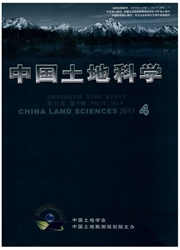

 中文摘要:
中文摘要:
研究目的:揭示长江中下游地区耕地后备资源的分布变化特征及其影响因素,以指导耕地后备资源开发。研究方法:重心模型、标准差椭圆等空间统计方法。研究结果:(1)相比2003年,2014年长江中下游地区耕地后备资源重心呈现向西南移动的趋势,耕地后备资源空间分布范围扩大,空间分布方向性减弱,主趋势方向呈顺时针旋转;(2)在长江中下游地区耕地后备资源分布变化的影响因素中,自然条件奠定了基本格局,人口分布的影响力逐步显现,经济发展是近年来变化的主导因素。研究结论:重心模型、标准差椭圆等空间统计方法能够从多视角揭示并可视化长江中下游地区耕地后备资源的空间分布特征并分析部分影响因素,可为耕地后备资源的开发政策提供理论指导。
 英文摘要:
英文摘要:
The purpose of this paper is to reveal the distribution and impact factors of reserved cultivated land resources in the middle and lower reaches of Yangtze River and to provide guidance for their development.Methods of the gravity center model and standard deviational ellipse are employed.The results show that: 1)During 2003—2014,the gravity center of reserved cultivated land resources moved to southwest,the spatial distribution of reserved cultivated land resources tended to expand,the directional distribution tended to be weakened and the direction of the major trend showed clockwise rotation.2)Natural factors are the foundations of the spatial distribution and variation.The influence from demographic factors has gradually emerged and economic factors have been decisive factors in recent years.It concluded that the methods of the gravity center model and standard deviational ellipse could project and visualize the spatial pattern of reserved cultivated land resources.It can also analyze parts of the factors and provide theoretical guidance for reserved cultivated land resources development.
 同期刊论文项目
同期刊论文项目
 同项目期刊论文
同项目期刊论文
 期刊信息
期刊信息
